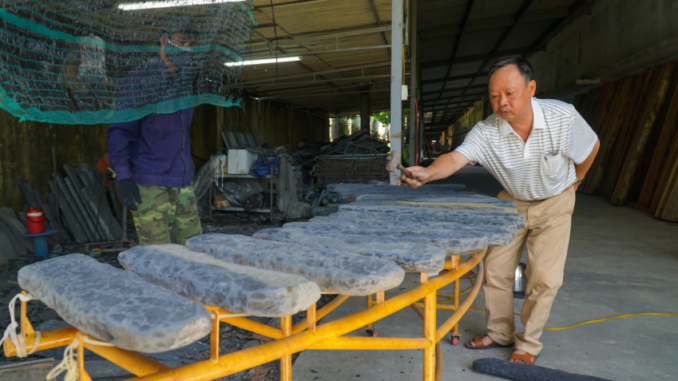
KHANH HOA – Over 30 years of tinkering by himself, Mr. Nguyen Phuong Dong, 62, in the Dien Khanh district, has crafted nearly 100 sets of stone lutes and sold them to artists and tourist facilities as exhibits and performances.

Located in Truong Son Craft Village in Dien Phu Industrial Cluster (Dien Khanh District), Mr. Dong’s zither-making workshop echoes the sound of chisels and chisels every day, and workers work hard to deliver them to customers.
As a musician, Mr. Dong has been tinkering with stone instruments for more than 30 years. At first, making the piano just to satisfy his passion. After that, many colleagues asked to buy, he just made and sold. In 2018, Mr. Dong’s workshop was born and so far has produced nearly 100 sets of rock guitars.
Dan Da is an ancient musical instrument of Vietnam, listed by UNESCO in the list of musical instruments in the space of gong culture in the Central Highlands. The guitar is made of stone bars with different lengths, lengths, thicknesses, and thins. The long, big, and thick rock bars have a low-pitched sound while the short, small, and thin rock bars have a soft sound.

Horn stone, also known as black stone at the workshop, is taken from the mountains in Khanh Vinh district, gray in appearance but made in glossy black. In the past, in order to earn stone, one had to go to the mountains in Khanh Vinh district to meet and guide the people on how to recognize this stone for mining, the artisan said. Now, sitting at Mr. Dong’s house, he can call to place an order and ask someone to bring it down. The cost of each stone transported to the place is about one million dongs.

Through the old documents, Mr. Dong said that new hornstone and rhyolite can be used as rock. However, he confirmed the fact that many types of rocks can make flocks, including coral. After a period of surveying in the coastal provinces of the South Central Coast – Central Highlands, Mr. Dong found that Khanh Hoa has a lot of stone reserves and much better quality.

The technique of chiseling, locating nodules on the rock. The process to create a rock instrument at the workshop is divided into 5 stages: Determining the reverberation and volume of the rock block; finding the grain of the stone to separate each stone; rough chisel to check the sound and meet the shape requirement of the stone; fine tuning for note positioning; Use the machine to return the stone to its original state (remove all cuts, sharpening and grinding on the stone).
“The stages look simple, but the worker must accumulate enough experience to make a standard guitar,” said Mr. Dong.

The worker grinds the stone to remove sharp edges after chiseling. This cuts down on the final stage of making the flock.

Mr. Dong signs musical notes for workers who do not know about music theory, which is easy to understand when making. According to him, training in stone lute making is more difficult than performing, because the lute maker must have musical knowledge.

The worker measures the height of the stone bar with specialized equipment. Based on the pitch of the stone bar, the worker will base it to adjust the sound accordingly.

Mr. Phan Huu Quan (Vinh Trung ward, Nha Trang city) has worked as a worker at a stone factory for more than two years. He said basic work is difficult but fun. “Working here, I feel proud because I can help the nation’s traditional culture get more attention,” Mr. Quan said.

Mr. Dong bought a concrete mixer, then made his own iron bars fixed inside. The stones will be put into rotation, to bring the stone face back to its original state. This is also the final stage to create complete stone guitars.

Finished products after the final stage.

Mr. Dong tested the sound of the stone lute set inspired by the national treasure set, consisting of 14 bars corresponding to 14 notes. This year, he has made 15 sets of rock guitars, and most of the orders are from Ho Chi Minh City. Last year, with the aim of preserving and promoting local cultural values, Khanh Son district ordered him to make 10 sets.
In the future, the artist hopes to be able to print into a book all the knowledge about the lute, from performing art to making the lute, creating a systematic system for those who want to access and learn.
